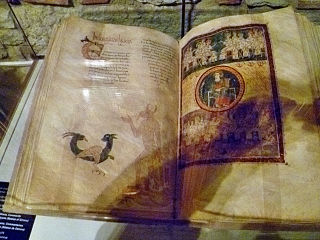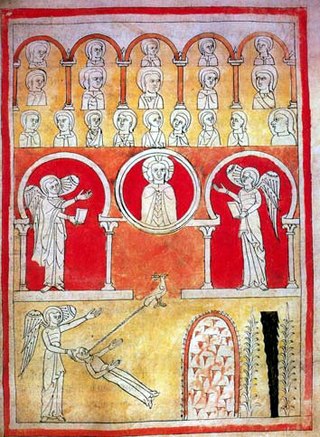
An illuminated manuscript is a formally prepared document where the text is decorated with flourishes such as borders and miniature illustrations. Often used in the Roman Catholic Church for prayers and liturgical books such as psalters and courtly literature, the practice continued into secular texts from the 13th century onward and typically include proclamations, enrolled bills, laws, charters, inventories, and deeds.

Beatus of Liébana was a monk, theologian, and author of the Commentary on the Apocalypse, mostly a compendium of previous authorities' views on the biblical Book of Revelation or Apocalypse of John. This had a local influence, mostly in the Iberian Peninsula, up to about the 13th century, but is today remembered mainly for the 27 surviving manuscript copies that are heavily illustrated in an often spectacular series of miniatures that are outstanding monuments of Mozarabic art. Examples include the Morgan Beatus and Saint-Sever Beatus; these are covered further at the article on the book. Most unusually for a work of Christian theology, it appears that Beatus always intended his book to be illustrated, and he is attributed with the original designs, and possibly the execution, of the first illustrations, which have not survived.

The Rabbula Gospels, or Rabula Gospels, is a 6th-century illuminated Syriac Gospel Book. One of the finest Byzantine works produced in West Asia, and one of the earliest Christian manuscripts with large miniatures, it is distinguished by the miniaturist's predilection for bright colours, movement, drama, and expressionism. Created during a period from which little art survived, it nevertheless saw great development in Christian iconography. The manuscript has a significant place in art history, and is very often referred to.

The Stockholm Codex Aureus is a Gospel book written in the mid-eighth century in Southumbria, probably in Canterbury, whose decoration combines Insular and Italian elements. Southumbria produced a number of important illuminated manuscripts during the eighth and early ninth centuries, including the Vespasian Psalter, the Stockholm Codex Aureus, three Mercian prayer books, the Tiberius Bede and the British Library's Royal Bible.

Ottonian art is a style in pre-romanesque German art, covering also some works from the Low Countries, northern Italy and eastern France. It was named by the art historian Hubert Janitschek after the Ottonian dynasty which ruled Germany and Northern Italy between 919 and 1024 under the kings Henry I, Otto I, Otto II, Otto III and Henry II. With Ottonian architecture, it is a key component of the Ottonian Renaissance. However, the style neither began nor ended to neatly coincide with the rule of the dynasty. It emerged some decades into their rule and persisted past the Ottonian emperors into the reigns of the early Salian dynasty, which lacks an artistic "style label" of its own. In the traditional scheme of art history, Ottonian art follows Carolingian art and precedes Romanesque art, though the transitions at both ends of the period are gradual rather than sudden. Like the former and unlike the latter, it was very largely a style restricted to a few of the small cities of the period, and important monasteries, as well as the court circles of the emperor and his leading vassals.

The Morgan Beatus is an illuminated manuscript with miniatures by the artist Magius of the Commentary on the Book of the Apocalypse by the eighth-century Spanish monk Beatus, which described the end of days and the Last Judgment. The manuscript is believed to have been produced in and around the scriptorium of the Monastery of San Miguel de Escalada in Spain.

The Utrecht Psalter is a ninth-century illuminated psalter which is a key masterpiece of Carolingian art; it is probably the most valuable manuscript in the Netherlands. It is famous for its 166 lively pen illustrations, with one accompanying each psalm and the other texts in the manuscript. The precise purpose of these illustrations, and the extent of their dependence on earlier models, have been matters of art-historical controversy. The psalter spent the period between about 1000 to 1640 in England, where it had a profound influence on Anglo-Saxon art, giving rise to what is known as the "Utrecht style". It was copied at least three times in the Middle Ages. A complete facsimile edition of the psalter was made in 1875, and another in 1984 (Graz).

The Escorial Beatus is a 10th-century illuminated manuscript of the Commentary on the Apocalypse by Beatus of Liébana. The manuscript was probably created at the monastery at San Millán de la Cogolla. There are 151 extant folios which measure 395mm by 225mm. The manuscript is illustrated with 52 surviving miniatures. Of the original illustrations within the commentary, twenty-seven of the original illustrations are left. Compared to other illuminated manuscripts, including other illuminated manuscripts at the time, the Escorial Beatus is slightly smaller in comparison. The Escorial Beatus is one of the most well-known illuminated manuscripts that make use of the Mozarabic style of art. This would later lead to influence other well known artistic styles, including styles like Romanesque and Carolingian.

Mozarabic art is an early medieval artistic style that is part of the pre-Romanesque style and emerged in al-Andalus and in the kingdom of León. It was developed by the Hispanic Christians who lived in Arab-Muslim territory and in the expansion territories of the León crown, in the period from the Arab-Islamic Conquest of the Iberian Peninsula (711) to the end of the 11th century. During this period, disciplines such as painting, goldsmithing and architecture with marked Caliphate influences were cultivated in a context of medieval coexistence - Christian, Hebrew and Muslim - in which the territories were constantly changing in size and status. Other names for this artistic style are Leonese art or repopulation art.

The Commentary on the Apocalypse is a Latin commentary on the biblical Book of Revelation written around 776 by the Spanish monk and theologian Beatus of Liébana. The surviving texts differ somewhat, and the work is mainly famous for the spectacular illustrations in a group of illustrated manuscripts, mostly produced on the Iberian Peninsula over the following five centuries. There are 29 surviving illustrated manuscripts dating from the 9th to the 13th centuries, as well as other unillustrated and later manuscripts. Significant copies include the Morgan, Saint-Sever, Gerona, Osma, Madrid, and Tábara Beatus codices.

The Gerona Beatus is a 10th-century illuminated manuscript in the museum of Girona Cathedral, Catalonia, Spain.
M. Moleiro Editor is a publishing house specialising in high-quality facsimile reproductions of codices, maps and illuminated manuscripts. Founded in Barcelona in 1991, the firm has reproduced many masterpieces from the history of illumination.

The Urgell Beatus, Beatus d'Urgell or Beatus la Seu d'Urgell is a 10th-century illuminated manuscript of the Commentary on the Apocalypse by the 8th-century monk Beatus of Liebana, now in the Musei Diocesá de La Seu d'Urgell, at La Seu d'Urgell, Spain.

The Hedwig Codex, also known as the Codex of Lubin, is a medieval illuminated manuscript from the mid-14th century. It comprises sixty-one colored drawings and inscriptions which tell the life of Saint Hedwig, High Duchess of Poland and Silesia, her family, and events related to her canonization in 1267. The Hedwig Codex details both the married life of the Hedwig and her life within the Cistercian nunnery of Trebnitz. This art piece, a fine example of Central European Gothic art, is valued especially for its depictions of the Mongol invasion of Europe and Poland.

The Apocalypse of Lorvão is an illuminated manuscript from Lorvão, Portugal containing the Commentary on the Apocalypse of Beatus of Liébana Monastery, Spain.

The Tábara Beatus or Beatus of Tábara is a 10th-century illuminated manuscript, containing the Commentary on the Apocalypse by Beatus of Liébana. It originated in the San Salvador de Tábara Monastery and is now held in Spain's National Historical Archive in Madrid under the catalogue number L.1097B. Only eight of its original hundred miniatures survive.

The León Bible of 960 or Codex Biblicus Legionensis is a mozarabic Bible manuscript copied and illuminated in 960 at the monastery of Valeránica in Tordómar. It is now held in the library of the Basílica de San Isidoro, León - why it moved there is unknown, though the monastery in which it was produced disappeared at the end of the 10th century and so it could have been given to the Basilica during the 11th century by Ferdinand I of Leon and his wife Sancha, the main patrons of the basilica.

The Cloisters Apocalypse, MS 68.174 is a French illuminated manuscript dated c. 1330, now in The Cloisters in New York. There are 40 folios, that is to say, 80 pages. The page size is 12 1/8 × 9 1/16 in.. There is a high level of illustration, with 72 half or full-page miniatures, as well as coats of arms and decorated initials in red & blue.

The Birds' Head Haggadah is the oldest surviving illuminated Ashkenazi Passover Haggadah. The manuscript, produced in the Upper Rhine region of Southern Germany in the early 14th century, contains the full Hebrew text of the Haggadah, a ritual text recounting the story of Passover – the liberation of the Israelites from slavery in ancient Egypt – which is recited by participants at a Passover Seder. The text is executed in block calligraphy and accompanied by colorful illustrations of Jews performing the Seder practices and reenacting Jewish historical events.

The Spanish illumination of the Early Middle Ages is the art of decorating books that developed in Spain from the 8th to the 11th. The country was marked by the Muslim occupation from 711, which tended to isolate it from the rest of Europe. In the regions that remained Christian, first in the Kingdom of Asturias and then in León, an original art was invented in monasteries, mixing Visigothic, Carolingian, and also Moorish influences.

















